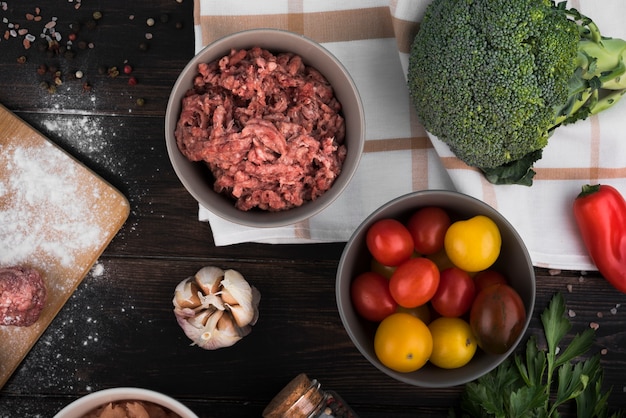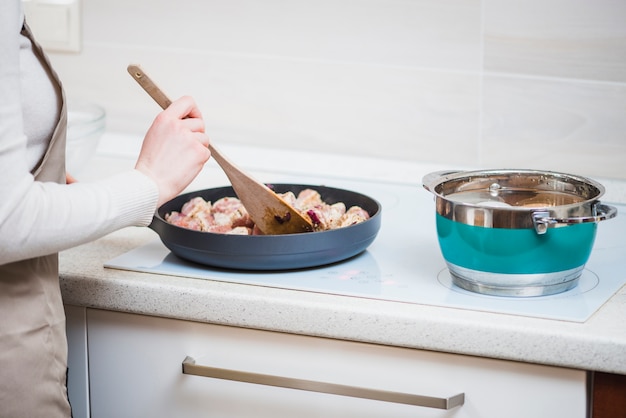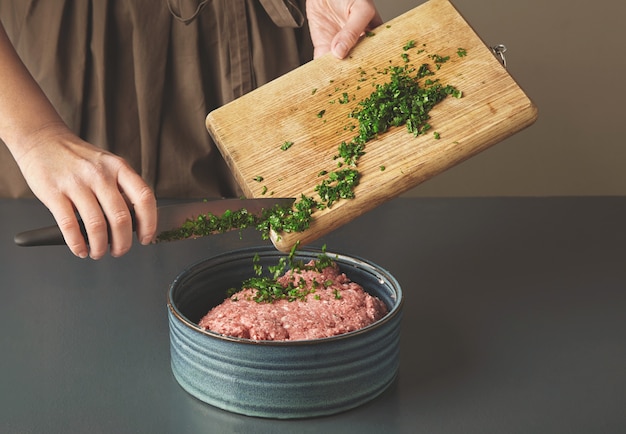The aroma of a perfectly cooked ham fills the air with a comforting warmth, promising a delicious feast. It's a staple for holiday gatherings, family dinners, and even casual weeknight meals. But figuring out how to cook a ham to achieve that perfect balance of tenderness and flavor can be a bit of a puzzle. Enter the trusty crockpot, a kitchen workhorse that transforms a whole ham into a succulent masterpiece with minimal effort.
I've been a passionate home cook for years, and let me tell you, I've tried all sorts of methods for cooking ham: roasting in the oven, baking it on the grill, even experimenting with smoking. But nothing quite compares to the effortless ease and incredible flavor that a crockpot brings to the table. The gentle, slow heat of the crockpot works its magic, breaking down tough fibers and infusing the meat with juicy goodness. It's a method that truly allows the flavors to develop, resulting in a melt-in-your-mouth experience that's simply divine.
So, gather your ingredients, grab your favorite crockpot, and get ready for a delightful culinary adventure. I'll guide you through every step, from choosing the right ham to nailing those perfect cooking times. We'll even explore some creative ways to elevate your crockpot ham to new heights of deliciousness.
Part 1: Choosing the Right Ham

The journey to a delectable crockpot ham begins with selecting the perfect star of the show: the ham itself. Choosing wisely is key, as it sets the stage for your culinary masterpiece. Here's a breakdown of what to consider:
1. Fresh vs. Cured: A Flavorful Decision
First, you'll need to decide between fresh and cured ham. fresh ham is unprocessed and typically leaner, but it requires brining or curing before cooking. This method involves soaking the ham in a salt solution, which draws out moisture and adds flavor, resulting in a ham with a more delicate texture. While fresh ham offers a clean, natural flavor, it does require extra preparation.
Cured ham, on the other hand, is already seasoned and ready to cook straight from the package. It's been cured with salt, sugar, and often other seasonings like nitrates or nitrites, giving it a distinct salty, smoky flavor that many find irresistible. I personally favor cured ham for its convenience and its inherent flavorful profile.
2. Bone-in vs. Boneless: Versatility vs. Flavor
Once you've chosen your ham type, consider whether you prefer bone-in or boneless. bone-in hams are typically more flavorful, as the bone adds richness and depth to the meat during cooking. They also tend to be more affordable than boneless hams. However, bone-in hams are less versatile in terms of slicing and require a bit more effort to carve.
Boneless hams are more convenient, offering easy slicing and versatility for various dishes. However, they might lack a touch of the bone-in ham's depth of flavor. The choice ultimately comes down to your preferences and the dish you envision.
3. Size and Weight: The Perfect Portion
Finally, consider the size and weight of your ham. This will significantly influence your cooking time. A smaller ham, say 4-6 pounds, will cook much faster than a larger, 10-12 pound behemoth. Choose a size that suits your needs and the number of people you'll be serving. A larger ham is ideal for a big gathering, while a smaller one is perfect for a more intimate dinner.
Part 2: Prepping Your Ham for the Crockpot

Now that you've got your ham chosen, it's time to give it a little TLC before it enters the crockpot. This seemingly small step can elevate your ham to a whole new level of flavor and tenderness.
1. Scoring the Fat: A Key to Juicy Goodness
Start by scoring the fat of your ham. This might seem a bit intimidating, but trust me, it's a simple trick that makes a world of difference. It allows the fat to render during cooking, releasing flavorful juices and creating a beautifully caramelized crust.
Using a sharp knife, make shallow, criss-cross cuts across the fat, about 1/4 inch deep. Don't be afraid to get creative with the patterns! You can even make diamond-shaped cuts for a decorative effect.
2. Glazing It Up: A Symphony of Flavors
I love adding a homemade glaze to my ham. It creates a gorgeous glossy finish and adds another layer of flavor that complements the ham's inherent taste. My go-to glaze is a simple mixture of brown sugar, honey, and mustard. The sweetness of the brown sugar and honey balances the tangy mustard, creating a delightful flavor profile.
You can get creative with your glaze too! Experiment with different combinations: try adding apple cider vinegar for a tangy kick, maple syrup for a richer sweetness, or even fruit preserves like apricot or blackberry for a unique twist. Remember to spread the glaze generously over the ham before putting it in the crockpot, ensuring every inch is coated.
3. Adding Aromatics: A Bouquet of Flavor
For an extra layer of flavor, add some aromatics to your crockpot. A few cloves of garlic, a small onion, or fresh herbs like thyme or rosemary will infuse the meat with their captivating scents as it cooks. Just toss them in with the ham and let them work their magic. Experiment with different combinations based on your taste preferences.
Part 3: Crockpot Cooking Time: Mastering the Art of Slow and Steady

Now comes the exciting part: the actual cooking! The secret to perfect crockpot ham lies in timing. The slow, gentle heat of the crockpot allows the ham to cook evenly, breaking down the fibers and releasing the juices, creating a tender, juicy result.
1. Cooking Time Chart: A Guide to Perfect Doneness
Here’s a general guideline for crockpot ham cooking times based on the size and weight of your ham:
| Ham Weight (lbs) | Cooking Time (hours) |
|---|---|
| 4-6 | 6-8 |
| 6-8 | 8-10 |
| 8-10 | 10-12 |
| 10-12 | 12-14 |
Remember, these are just general guidelines. It's always better to err on the side of caution and cook for a little longer if you're unsure. Overcooked ham can become dry and tough, so ensuring it's cooked through but still juicy is key.
Part 4: Checking for Doneness: Ensuring perfect tenderness
No one wants to end up with a dry, overcooked ham. That's why it's crucial to check for doneness before you declare it ready.
1. The internal temperature Method: A Reliable Test
The most reliable way to check for doneness is by using a meat thermometer. Simply insert the thermometer into the thickest part of the ham, making sure to avoid bone. The ham is cooked through when the internal temperature reaches 145°F (63°C). This ensures that the ham is safe to eat and perfectly cooked.
2. The Fork Test: A Simple Alternative
If you don't have a meat thermometer, you can use the fork test. Insert a fork into the thickest part of the ham. If the fork slides in easily and the meat pulls apart, it's cooked through. However, this method is less precise than using a thermometer, so it's best to use it in conjunction with visual cues like the ham's color and texture.
Part 5: Finishing Touches: Elevating the Flavor
Your ham is cooked, the aroma is divine, and it's almost time to dig in. But hold your horses! A few finishing touches can take your crockpot ham from good to incredible.
1. Shred or Slice: Adapting to Your Needs
Once the ham is cooked, remove it from the crockpot and let it cool slightly. You can then shred the ham using two forks or slice it into thin pieces. Shredding is ideal for sandwiches, salads, or soups, while slicing is perfect for a more elegant presentation.
2. Making a Delicious Sauce: Transforming the Juices
The juices left in the crockpot are a culinary treasure – they're the foundation for an incredible sauce. Strain the juices through a fine-mesh sieve, discarding the solids. This will create a clear, flavorful broth. You can then thicken the sauce by reducing it over medium heat or by adding a tablespoon of cornstarch mixed with a little cold water.
For an extra burst of flavor, consider adding a splash of your favorite vinegar, like apple cider vinegar or white wine vinegar, to the sauce. It adds a delightful tanginess that complements the ham beautifully.
Part 6: Serving Your Delicious Ham: A Feast for the Senses
Now, for the moment we've all been waiting for: the grand unveiling of your perfectly cooked crockpot ham!
1. A Feast Fit for a King: A Culinary Celebration
Serve the ham hot, alongside your favorite sides. Classic pairings include mashed potatoes, green beans, sweet potatoes, or a simple salad. The richness of the ham pairs well with creamy mashed potatoes, the sweetness of sweet potatoes, and the freshness of a crisp salad. You can also add a touch of whimsy with cranberry sauce or a tangy mustard dipping sauce.
2. Leftover Magic: Endless Culinary Possibilities
One of the best things about crockpot ham is that it makes for incredible leftovers. Store the leftover ham in the refrigerator for up to 4 days. It's perfect for making ham sandwiches, adding to soups, or using in a hearty breakfast casserole.
Part 7: Beyond the Basics: Embracing Culinary Creativity
Once you've mastered the basics of cooking ham in a crockpot, you can experiment with different flavors and techniques.
1. Spice It Up: A Dash of Heat
For a spicy kick, add a few jalape??os, habaneros, or a splash of hot sauce to your glaze. You can also add a pinch of chili powder or cayenne pepper to your crockpot as the ham cooks.
2. Go Sweet and Savoury: A Balanced Delight
For a sweet and savory flavor combination, add a few apples, pears, or pineapple slices to the crockpot with the ham. The fruit will caramelize as it cooks, adding a delightful sweetness that contrasts beautifully with the savory ham.
3. Elevate with Herbs: A Fresh and Fragrant Twist
For a fragrant touch, add fresh herbs like rosemary, thyme, or sage to the crockpot. You can tie them together with twine and place them alongside the ham, or simply scatter them throughout the crockpot.
Part 8: FAQs: Addressing Common Concerns
You're all set to create a culinary masterpiece, but if any questions pop up, here are a few I often get asked:
1. Can I Cook a Ham in a slow cooker on High?
It's generally not recommended to cook ham on high in a slow cooker. The high heat can lead to overcooking and a dry, tough ham. It's always best to cook ham on low for a longer period, allowing the flavors to develop evenly and the meat to become incredibly tender.
2. Can I Add Water to the Crockpot?
Adding a little water to the bottom of the crockpot can help keep the ham moist, but it's not strictly necessary. Just make sure the ham isn't sitting directly in the water. You want the ham to be submerged in its own juices, creating a flavorful broth that you can use to make a delicious sauce later on.
3. What Can I Do with the Leftover Ham Bone?
Don't throw away the ham bone! It's packed with flavor. You can use it to make a delicious ham and bean soup, a hearty ham broth, or even add it to a pot of rice for extra flavor. The bone will infuse your dish with a rich, savory flavor that's simply irresistible.
4. How Long Can I Store Cooked Ham in the Refrigerator?
Cooked ham can be stored in the refrigerator for up to 4 days. Make sure to wrap it tightly in plastic wrap or foil to prevent drying out. This will keep the ham moist and flavorful for days.
5. Can I Freeze Cooked Ham?
Yes, you can freeze cooked ham. Wrap it tightly in freezer paper or plastic wrap and freeze for up to 2 months. Defrost the ham in the refrigerator overnight before reheating. Freezing is a great way to preserve the ham for later use, making it a convenient option for busy schedules.
Part 9: Crockpot Ham: A culinary journey
Cooking ham in a crockpot is a simple, satisfying culinary experience. It's a perfect way to impress your guests with a delicious, flavorful, and tender ham that melts in your mouth. It's also a fantastic way to use up leftovers in creative ways, ensuring nothing goes to waste. So, grab your crockpot, choose your favorite ham, and get ready to embark on your own delicious crockpot ham journey. Bon appétit!
Everyone is watching

Prime Rib Roast Cooking Time Chart: Per Pound Guide
Cooking TipsPrime rib roast. Just the name conjures images of lavish dinners, crackling fires, and hearty laughter. It’s ...

How Long to Bake Potatoes in the Oven (Perfect Every Time)
Cooking TipsBaked potatoes are a staple in my kitchen. They're incredibly versatile, delicious, and surprisingly easy to m...

Perfect Rice Every Time: The Ultimate Guide to Cooking Rice
Cooking TipsAs a self-proclaimed foodie, I've always been a bit obsessed with rice. It's the foundation of countless cuisi...

The Ultimate Guide to Cooking Asparagus: Tips, Techniques, and Recipes
Cooking TipsAsparagus. The mere mention of this spring delicacy conjures up images of vibrant green spears, crisp and burs...

Ultimate Guide to Cooking the Perfect Thanksgiving Turkey
Cooking TipsThanksgiving. Just the word conjures up images of overflowing tables laden with delicious food, the scent of r...
